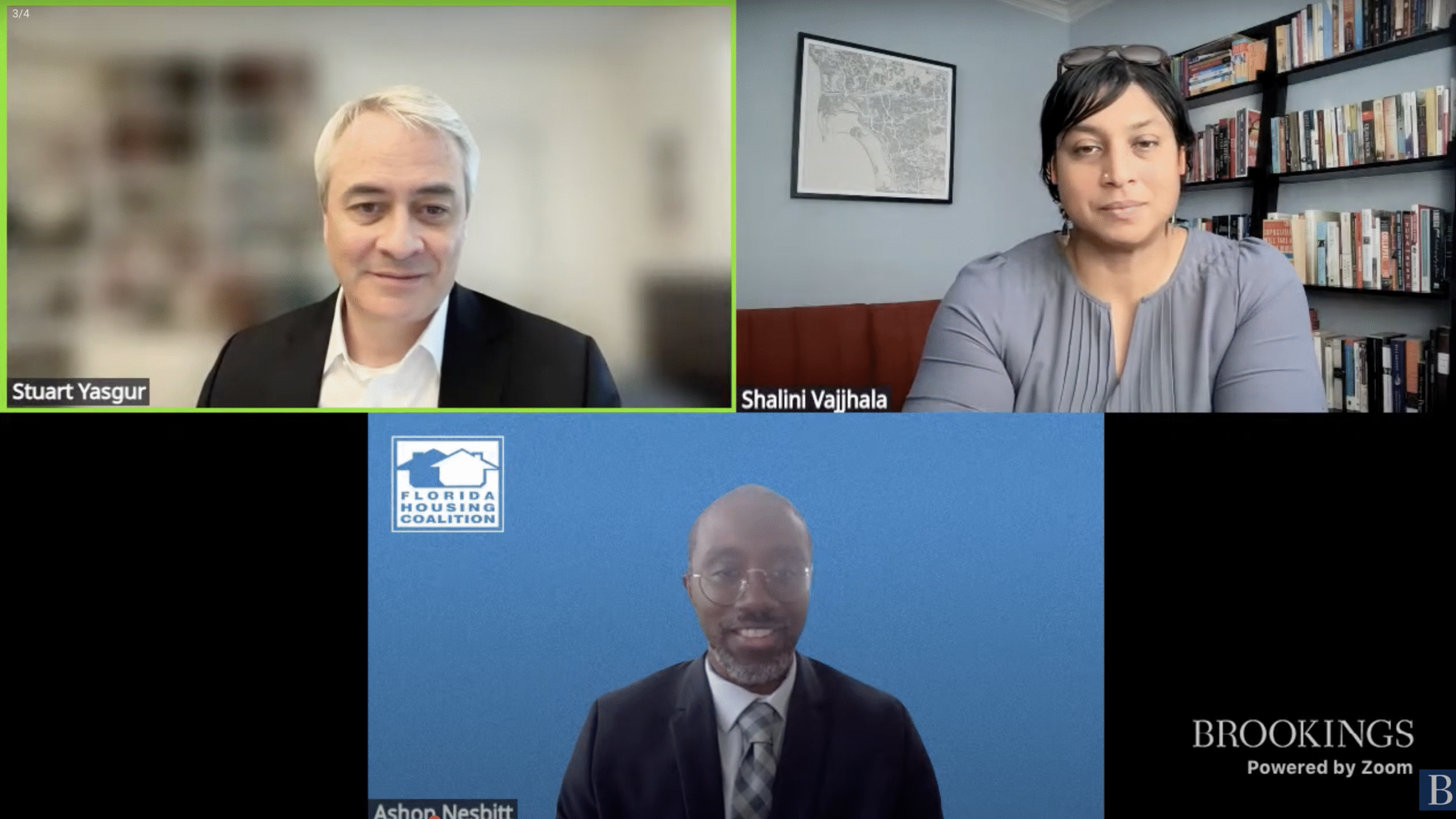On June 17, 2025, Economic Architecture and Brookings hosted the first in a series of conversations on building resilient homes and communities in the face of escalating weather-related disasters, with the online event, “Building resilience: How structural innovations can help communities defend against disasters.”
The Safe, Healthy, and Resilient Homes event featured:
- Mannan Donoghoe, Fellow, The Brookings Institution
- Ashon Nesbitt, CEO, Florida Housing Coalition
- Shalini Vajjhala, Executive Director, PRE Collective
- David Wessel, Senior Fellow – Economic Studies, The Brookings Institution and Director, Hutchins Center on Fiscal and Monetary Policy
- Stuart Yasgur, Founder and Principal, Economic Architecture
Why building climate resilience matters now
The speakers discussed the growing impact of climate disasters on communities, homes, and individuals across the U.S. Ashon Nesbitt and Shalini Vajjhala showcased innovations currently underway that have the potential to create meaningful, structural change focused on mitigation and resilience.
Watch the full video of the event.
Expert insights on climate resilience and policies
“Not so long ago, climate change was something experts warned about, but few of us actually felt it, at least in the US,” offered David Wessel of Brookings. ‘But that has changed. The severity of hurricanes in Florida, the floods in North Carolina and West Virginia, tornadoes in the Midwest, wildfires in California; and the issues of availability and affordability of homeowners insurance present macroeconomic challenges to the mortgage market, housing market, and also microeconomic challenges to individual homeowners and prospective home buyers.”
Economic Architecture’s Stuart Yasgur agreed, adding: “Recently, we’re seeing families get displaced and homes destroyed in regions that weren’t even considered at risk 10 years ago. Today, an estimated 130.7 million people, 41% of the US population, live in areas that are regularly affected by major disasters, from California to the Carolinas, from Texas to Maine…We need to build safer and more resilient homes and communities, and that will require a broad range of new innovations that can create change at the structural level.”
“The number and severity of disasters are increasing, but according to our research, disaster impacts are actually more a product of social and economic vulnerability, rather than the number of events,” said Mannan Donoghoe of Brookings, sharing recent research. “Factors like wealth and income, access to healthcare, affordable housing, quality of the health environment, the density of city infrastructures [amplify the severity of disasters]. We can’t just treat disasters as only a physical problem with an engineering solution.”
Affordable housing as a climate resilience strategy
Ashon Nesbitt, CEO, Florida Housing Coalition and a Spotlight Innovator in the Valuing Homes in Black Communities Challenge from Economic Architecture and The Brookings Institution, spoke about his organization’s commitment to building permanently affordable, climate-resilient housing:
“[Affordable housing] is important for the health of a community, as well as community identity. In 2017, when we experienced Hurricane Irma, I got an opportunity to go down to the Florida Keys and see it up close and personal. Most of the affordable housing for the workforce there was virtually destroyed. A lot of it was manufactured housing and just wasn’t built to current standards. To see it destroyed and know those folks might not have the opportunity to come back—that inspired the last seven years of figuring out, how do we marry those two [values] and really create a system by which we’re building both permanently affordable and resilient housing?”
Rethinkinking resilience beyond the status quo
Shalini Vajjhala, Executive Director, PRE Collective and a Nonresident Senior Fellow with Brookings Metro, emphasized that when resilience is built into systems, the successes are often invisible because they stop disasters from becoming notable. That drives her work to educate communities and elected officials about the value of resilience.
“There are three major things that guide our work at PRE Collective. The first is that when we get resilience right—a storm hit, and the community wasn’t wiped out—we need a really different way of capturing the value of an avoided loss.
“The second thing that really drives our work is that just holding people to a status quo or bringing them back up to a status quo after a disaster feels like a complete failure of imagination. We should be able to do better. All that early, messy stuff that you have to do with communities, homeowners, renters, and local governments and state agencies, to build what you need next, [do that] instead of doing the familiar thing and just putting Band-Aids on.
“The third critical piece of what we do is really that we look to bring together three key building blocks for resilience and innovation at the systems level: vision, capacity, and money.”
The road ahead
Economic Architecture and Brookings are developing what we hope will be a long-term initiative that’s focused on fostering the kinds of structural innovations we need to address weather-related disasters and build Safe, Healthy, and Resilient Homes. Join us for regular conversations with innovators online and in person, and for a podcast series of one-on-one conversations with experts who demonstrate how we can take concrete action for a better tomorrow.
